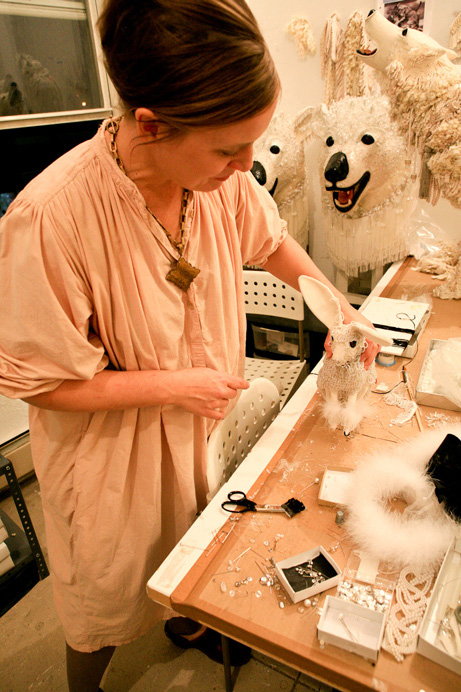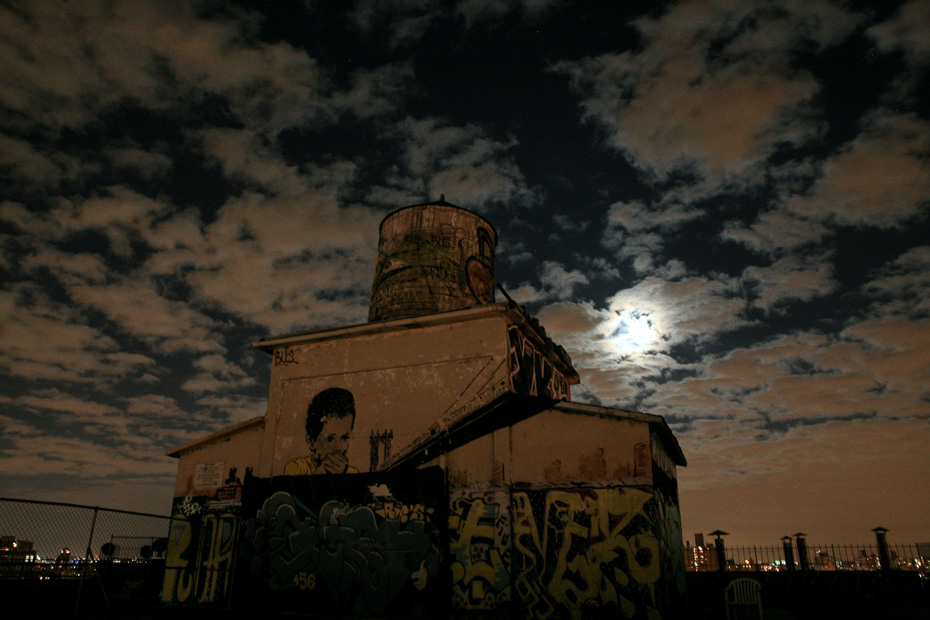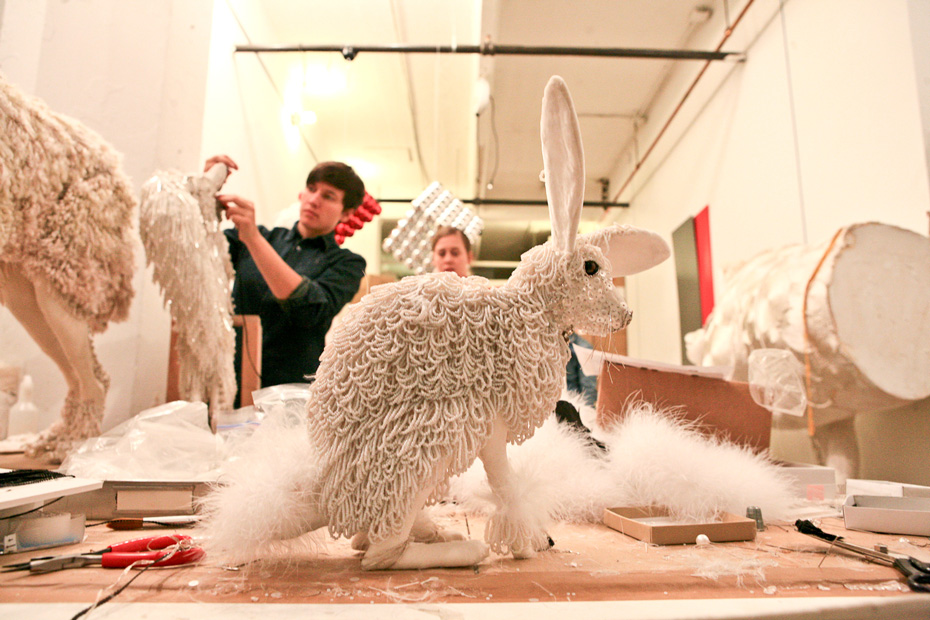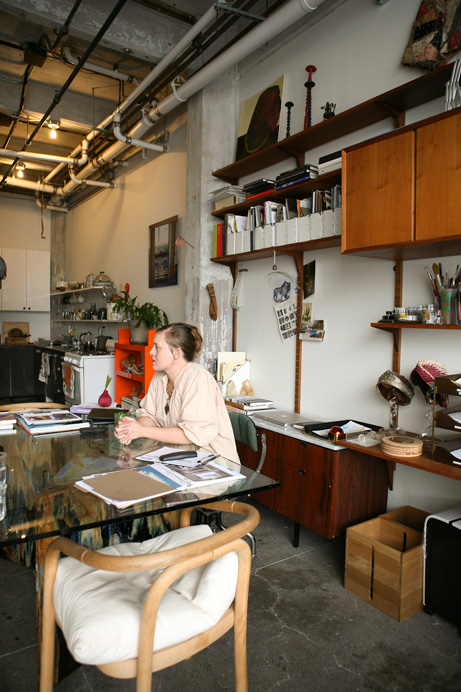Every year, just as the holiday season begins, the windows of the big department stores turn into imaginative wonder worlds and Johanna Burke is one of the masterminds behind the spectacle. She welcomed us with open arms and when scheduling a time for the interview she already was in the final production stages of her holiday display at Bergdorf Goodman. With foresight she summoned us to her place just a couple hours before the sun was about to set and invited us to a stunning nature show – certainly also keeping in mind how the lighting will affect the photography.
She was a fantastic host and we literally hung out most of the interview on her couch, enjoyed some sparkling wine and in the end witnessed a stunning sunset from her panoramic window overlooking the East River and Downtown Manhattan. She not only showed us to her wonderful apartment but also walked us through long, spooky concrete corridors of the building – mainly inhabited by artists – to her studio where she was working on the final touches to her holiday windows devoted to the theme „Carnival of the animals“.
































How did you get started with what you’re doing? How could you best describe your range and your disciplines?
Well, I started sort of accidentally by just coming to New York with an interest in art and wanted to have shows and doing that whole hustle. But getting closer to it, I realized it wasn’t really my thing. When I first moved here, I lived on 17th Street when Barney’s was still there, and you’d see these cool people in the window. It was a mystery who these people were and then one day, one of my roommates came home and said, “There was a kid in there with green hair. Like, you could go do that.” We didn’t realize it was actual artists doing that. There’s that time when you’re young and you want to do all this stuff but you don’t really know anybody or how to get in. I interviewed at Macy’s and it’s so fortunate I never got hired there because I think it would have been really rough to actually try to deal with that huge store.
How did you start working with Bergdorf Goodman?
I think I only got into Bergdorf’s because it’s kind of very hands-on, although it’s really luxury retail, it’s also very small and familiar. I got in solely because of the chaos of it. I just was able to slip in in 1998. Over the years, it just became something I realized I really enjoyed doing. They’re my home base.
Can you describe the process of doing a window for a client?
The studio now does very complicated things that fulfill people’s fantasies. Clients come to me with a problem and they need a really pretty solution for it and we figure it out. It may not always be what they think they want because if they knew what they wanted then they would’ve just given me a specific assignment. My role is evolving, but historically the work is very much a collaboration. For a large store with a creative department I am working directly with a designer or creative director and listen very deeply to what their space or brand needs. For smaller stores I provide the design. We work from vague to specific. We give them a menu, a few ideas, a little mood board…
What happens with the displays after the seasons?
Some of it is garbage which I’m very uncomfortable with, as the daughter of environmentalist. But often times the brands take the display and use it in their own showrooms. Some stuff does get reused. Bergdorfs often reuses the items I make for them, they are referred to as “legacy props”
Tell us about the openings, the reveal of the windows.
There is not always an opening. Usually you’re really tired from a long week of installing. Until the last minute we pull in the last things to finish up the window; One year I was running between the catering and sound systems to literally fill up the window as the party was being set up. And then 15 minutes before the window presentation you run upstairs and change from your dungarees to a party at Bergdorf’s. I think after one glass of champagne, its nearly a hallucinogenic experience. Everybody on average works around 60 to 80 hour a week on the installation week. Now, I do try to enjoy the openings because it gives you a sense of closure you need to have if you work on such a big project.
Do you consider yourself an artist?
I do consider it art. I just don’t work in a gallery setting. That’s not the path I took.
Where are you originally from?
I was born in Oregon and I grew up in California. I grew up in Fresno, California and went to school in Santa Cruz and then moved here while I was still in college basically.
How long have you been living in New York?
I moved here in ’94. After five years, it got a little easier. After 10 years, you kind of cross that threshold and you think, okay, all the stuff starts to come around and pay off a little bit. After 15, it does get a lot easier. This is the first apartment I’ve lived in that I don’t want to leave. Every other apartment I would decorate to tolerate it, but this one, you can start at a different place. It’s a beautiful place. I don’t really need to do much. Well, actually I did get rid of a lot of things that somebody else had done before I moved in just to make it more its original shell.
What do you like most about the city? What wouldn’t you be able to live without?
People. The intelligence and the excitement of people. I just love that there’s all these things happening: people making things, getting excited and having conversations about it. Just being around artists. I think New York is a really beautiful place. Just the weather and everything this month has been so beautiful. If I ever should get sick of people, I’ll move somewhere else to be around plants or something.
Do you go upstate?
Yeah. I spend time in the Hudson and Woodstock area up there.
Where do you get your furniture from?
From all over. Junk and antique stores, flea markets and I look on ebay. The modular Paul Cadovious shelving I have purchased from many different sources and cobbled it together. There is this shady guy in Long Island that I’ve noticed is selling individual pieces and I have bought some items from him to complete the office. But he’s kind of a creep.
How often do you close your curtains? This view is amazing.
In the summer, when it gets really hot in the daytime, we keep them closed. At night, the light is too beautiful. It keeps you totally connected to nature. I see the moon. I see the sunrise. I see the sunset. I enjoy seeing the light changing. It’s so easy in New York to forget we’re on the water. It’s a real gift. The woman who manages the building is a little bit of a matchmaker. I just had to tell her that I want to be in light. Before – my old studio was right by the Manhattan Bridge, in this otherwise crappy building with crappy landlords.
What do you know about this building?
It was built as a La Rosa pasta factory and apparently some of the cauldrons are still downstairs in the basement. There was also an illegal matzo factory in the basement.
How important is music to you?
Very. It was a neglected part of my life , at some point I just looked at my iTunes and realized I hated half the music that was on there. Especially when you’re working in a studio, you always need new stuff. So I enlisted a friend to be my musical coach. Since then I go to record stores in town and force myself to look for music seasonally and buy things I know nothing about. Actually, I like it so much now that I go on a monthly-basis to buy stacks of records and cds. I go to Other Music because I like the people who work there and they’re so very helpful. I usually am still too shy to talk to them, but I read their listings.
Do you like to cook?
Yeah. That is probably my lifelong art. I care about people’s experience and take hostessing very seriously. When I am working with a store it isn’t really that much of a difference. You’re giving somebody a good experience when they walk in to a place, helping them know their place, helping them understand what’s going on. Whenever I can, I have people over.
Thank you so much for the great afternoon and nice talk.
Go have a look at the website of Johanna for more info and work.
Photography: Grace Villamil
Interview: FvF
